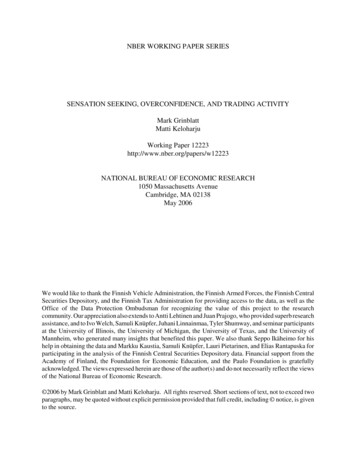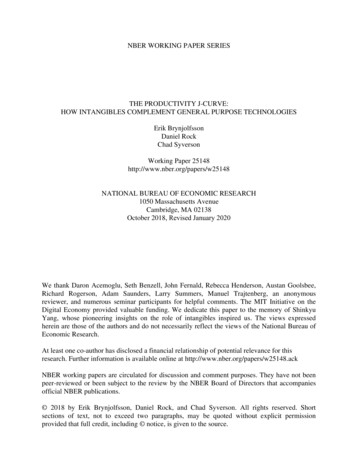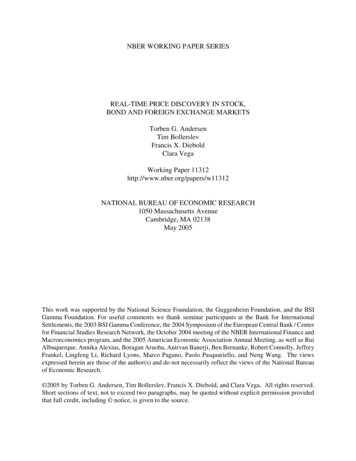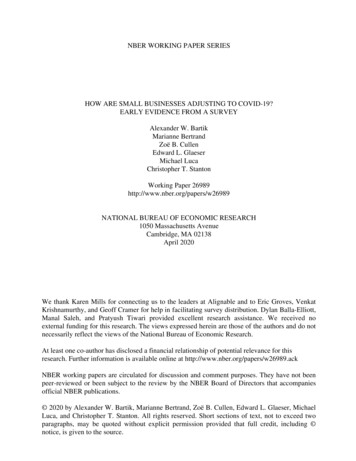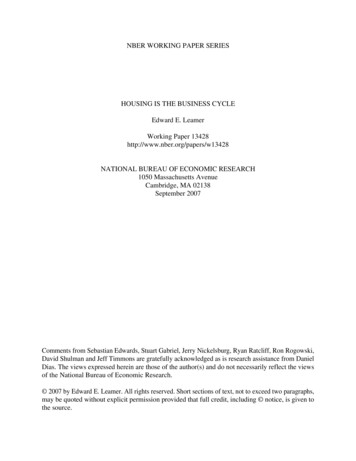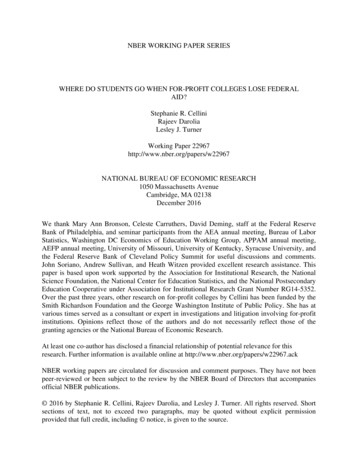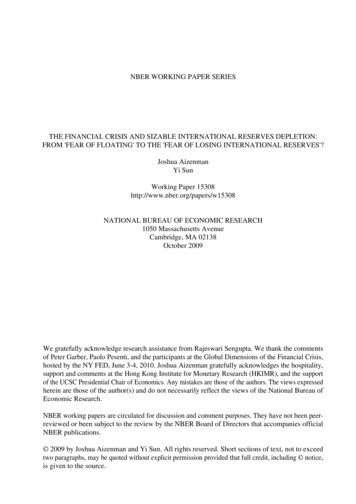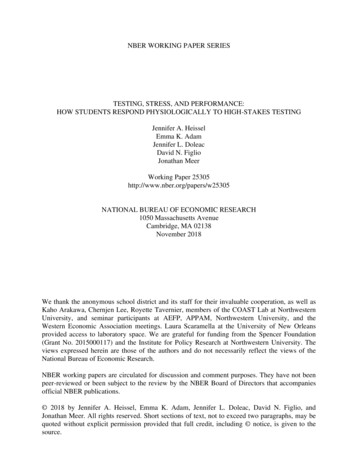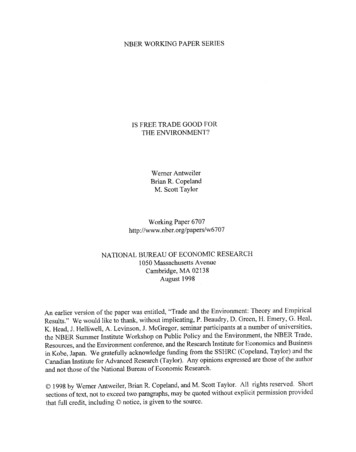
Transcription
1. IntroductionThe debate over the role international trade plays in determining environmentaloutcomes has at times generated more heat than light. Theoretical work has been successfulin identifying a series of hypotheses linking openness to trade and environmental quality, butthe empirical verification of these hypotheses has seriously lagged. Foremost among these isthe pollution haven hypothesis that suggests relatively low-income developing countries willbe made dirtier with trade. Its natural alternative, the simple factor endowment hypothesis,suggests that dirty capital intensive processes should relocate to the relatively capitalabundant developed countries with trade.Empirical work by Grossman and Krueger(1993), Jaffe et al. (1995) and Tobey (1990) cast serious doubt on the strength of the simplepollution haven hypothesis because they find trade flows are primarily responsive to factorendowment considerations and apparently not responsive to differences in pollutionabatement costs. Does this mean that trade has no effect on the environment?This paper sets out a theory of how "openness" to international goods markets affectspollution levels to assess the environmental consequences of international trade. We developa theoretical model to divide trade's impact on pollution into scale, technique andcomposition effects and then examine this theory using data on sulfur dioxide concentrationsfrom the Global Environment Monitoring Project. The decomposition of trade's effect intoscale, technique and composition effects has proven useful in other contexts [see Grossmanand Krueger (1993), Copeland and Taylor (1994,1995)] and here we move one step forwardto provide estimates of their magnitude. We find that international trade creates relativelysmall changes in pollution concentrations when it alters the composition, and hence thepollution intensity, of national output. Combining this result with our estimates of scale andtechnique effects yields a somewhat surprising conclusion: if trade liberalization raises GDPper person by 1%, then pollution concentrations fall by about 1%. In the case of sulfurdioxide concentrations, free trade is good for the environment.We obtain this conclusion by estimating a very simple model highlighting theinteraction of factor endowment and income differences in determining the pattern of trade.Our approach, while relatively straightforward, is novel in three respects.First, byexploiting the panel structure of our data set, we are able to distinguish empirically between2
the negative environmental consequences of scalar increases in economic activity - the scaleeffect - and the positive environmental consequences of increases in income that call forcleaner production methods - the technique effect. This distinction is important for manyreasons.1 Our estimates indicate that a 1% increase in the scale of economic activity raisesconcentrations by approximately .3%, but the accompanying increase in income drivesconcentrations down by approximately 1.4% via a technique effect.Second, we devise a method for isolating how trade-induced changes in thecomposition of output affects pollution concentrations. Both the pollution haven hypothesisand the factor endowment hypothesis predict openness to trade will alter the composition ofnational output in a way that depends on a nation’s comparative advantage. For example inthe pollution haven hypothesis, poor countries get dirtier with trade while rich countries getcleaner.2 As a result, looking for a consistent relationship between additional pollution andopenness to trade (across a panel of both rich and poor countries) is unlikely to be fruitful.Instead we look for trade’s composition effect after conditioning on country characteristics.We find that openness per se, measured in a variety of ways, has very little consistent impacton pollution concentrations. Openness conditioned on country characteristics has however ahighly significant, but relatively small, impact on pollution concentrations.And lastly, our approach forces us to distinguish between the pollution consequencesof income changes brought about by changes in openness from those created by capitalaccumulation or technological progress. We find that income gains brought about by furthertrade or neutral technological progress tend to lower pollution, but income gains broughtabout by capital accumulation raise pollution. The key difference is that capital accumulationfavors the production of pollution intensive goods whereas neutral technological progressand further trade do not. One immediate implication of this finding is that the pollutionconsequences of economic growth are dependent on the underlying source of growth.Another more speculative implication is that pollution concentrations should at first rise and1For example, income transfers across countries raise national income but not output, whereas foreigndirect investment raises output more than national income. For these, and many other reasons, we needseparate estimates of technique and scale effects.2That is, the composition effect of trade for poor countries makes them dirtier while the compositioneffect for rich countries makes them cleaner. The full effect of trade may be positive even for poor countriesdepending on the strength of the technique and scale effects.3
then fall with increases in income per capita, if capital accumulation becomes a less importantsource of growth as development proceeds.The theoretical literature on trade and the environment contains many papers whereeither income differences or policy differences across countries drive pollution intensiveindustries to the lax regulation or low-income country. For example, Pethig (1976), Siebertet al. (1980), and McGuire (1982) all present models where the costs of pollution intensivegoods are lower in the region with no environmental policy. One criticism of these papers isthat while they are successful in predicting trade patterns in a world where policy is fixed andunresponsive, their results may be a highly misleading guide to policy in a world whereenvironmental protection responds endogenously to changing conditions. Empirical workby Grossman and Krueger (1993) suggests that it is important to allow policy to changeendogenously with income levels and in our earlier work (Copeland and Taylor (1994,1995)) we incorporated the Grossman-Krueger finding to investigate how income-induceddifferences in pollution policy determine trade patterns.While this earlier work produced several insights, it was limited because it ignoredthe potential role factor abundance could play in determining trade patterns. In contrast, themodel we develop here allows income differences and factor abundance differences to jointlydetermine trade patterns.This extension is important, especially in an empiricalinvestigation, because many of the most polluting industries are also highly capitalintensive.3The empirical literature in this area has progressed in three distinct ways. First,there are studies that primarily concern themselves with growth and pollution levels andinterpret their results as indicative of the relative strength of scale versus technique effects(for example, Grossman and Krueger (1993, 1995), Shafik (1994), Seldon and Song(1994), Gale and Mendez (1996), and Dean (1998)). Many of these studies also add ameasure of openness as an additional explanatory variable. There is a second group ofstudies that examines how trade flows may themselves be affected by the level of abatementcosts or strictness of pollution regulation in the trading partner countries. This approach waspioneered by Tobey (1990), and then employed in the context of the NAFTA agreement byGrossman and Krueger (1993) and for a large cross section of countries by Antweiler3See appendix B, section B.1 for evidence linking capital intensity and pollution intensity.4
(1996). Finally there are those studies that employ the U.S. Toxic Release Inventory to inferhow changes in production and trade flows has altered the pollution intensity of productionin both developed and developing countries. Work along these lines includes Low and Yeats(1992).Overall the results from these studies are best described as mixed.Apart fromspecific case studies, there is very little evidence linking liberalized trade in general withsignificant changes in the environment. In addition, there is little evidence that differences inabatement costs are a significant determinant of trade flows. There is, however, evidencethat increases in income will, after a point, lead to lower concentrations of some pollutants.But the role that trade plays in this process is not entirely clear. Finally, there is someevidence that the composition of exports of some developing countries have become dirtierover time but these results follow only from a relatively narrow set of toxic pollutantsrecorded in the U.S. inventory.Ideally an empirical investigation should be able to distinguish between the negativeenvironmental consequences of scalar increases in economic activity - the scale effect - andthe positive environmental consequences of increases in income that call for cleanerproduction methods - the technique effect. Grossman and Krueger and others interpret theirhump-shaped Kuznets curve as reflecting the relative strength of scale versus techniqueeffects, but they do not provide separate estimates of their magnitude.4 As well, an empiricalinvestigation should be able to identify how trade affects average pollution intensity ofnational output by altering its composition. Many studies include some measure of opennessin their regressions to capture a composition effect, but there is very little reason to believethat openness per se affects the composition of output in all countries in the same way.Without a measure of the compositional effects of trade, we cannot assess whether trade’sreal income gains come at the cost of a dirtier mix of national production. Finally, many ofthe existing studies have a very weak theoretical base and this makes inference difficult.Without a causal mechanism linking trade to consequent changes in the environment it isdifficult to isolate the effects of trade on the environment from other factors such as4Moreover we would argue income per capita is not an appropriate measure of scale, and hence theGrossman-Krueger finding does not reflect the relative strength of scale and technique effects. Gale andMendez (1996) separate scale and technique effects by using city population figures, but their method is notentirely satisfactory. See section 3.2 for further discussion.5
technological changes in abatement activity, capital accumulation, or other sources of realincome change.We would be the first to admit that our simple theoretical model carries a heavyburden in providing us with the structure needed to isolate and identify the implications ofinternational trade. We suggest however that earlier empirical investigations failed to find astrong link between environmental outcomes and freer trade precisely because they lacked astrong theoretical underpinning. With a more coherent theoretical framework we are able tolook in the "right directions" for trade's effect.The remainder of the paper is organized as follows. In section 2 we outline ourtheory and in section 3 we describe our empirical strategy. In section 4 we present ourempirical results estimating trade’s effect on pollution. Section 5 concludes. Appendix Acontains summary statistics for data, plus additional notes on data sources and methods.Appendix B contains some additional supporting materials. In Appendix C we report resultsfrom a series of sensitivity tests of our specification.2. Theory2.1. The modelA population of N agents lives in a small open economy that produces two finalgoods, X and Y, with two primary factors, labor, L, and capital, K. Industry Y is laborintensive and does not pollute. Industry X is capital intensive and generates pollution as aby-product. We assume constant returns to scale, and hence the production technology forX and Y can be described by unit cost functions cX(w,r) and c Y(w,r). We let Y be thenumeraire, set py 1, and denote the relative price of X by p.By choice of units, 1 unit of pollution is generated for each unit of X produced. Wecall this the base level of pollution and denote it by B.Producers have access to anabatement technology however, which for simplicity we assume uses only good X as aninput. For a given base level of pollution B, the amount of pollution abated, A, is given bythe function λA(xa,B), where xa is the amount of resources allocated to abatement. We will6
treat λ as a parameter that may be affected by technological change. Pollution emissions arethen given by B minus A, or:z [x – λA(xa,x)].(2.1)We assume A(xa,x) is linearly homogeneous, increasing, and concave in xa and x. Hencewe can writeA(xa,x) xa(θ),(2.2)where θ x a/x is the fraction of X output devoted to abatement, and a(θ) A(θ,1). Weassume there is no abatement without inputs, and that it is not possible to fully abate allpollution: i.e. a(0) 0 and λa(1) 1. Note our specification implies increasing marginalabatement costs since, for a given level of base pollution, there are diminishing returns toabatement activity.Using (2.2), we can rewrite pollution emissions (2.1) asz x[1 – λa(θ)].(2.3)ProducersWe can now specify the equilibrium conditions for the production side of theeconomy.We assume the government uses pollution emission taxes (which areendogenous) to reduce pollution. Given the pollution tax τ, the profits π x for a firmproducing X are given by revenue, less production costs, pollution taxes, and abatementcosts:π x px – cx (w,r) x – τ[1 – λa(θ)]x – pθx.(2.4)Firms will jointly choose gross output (x) and their abatement fraction θ to maximize profits.Define p p(1 – θ) – τ[1 – λa(θ)].Then (2.4) becomes:π x p x – cx (w
and Krueger (1993), Copeland and Taylor (1994,1995)] and here we move one step forward to provide estimates of their magnitude. We find that international trade creates relatively small changes in pollution concentrations when it alters the composition, and hence the pollution intensity, of national output. Combining this result with our estimates of scale and technique effects yields a .
